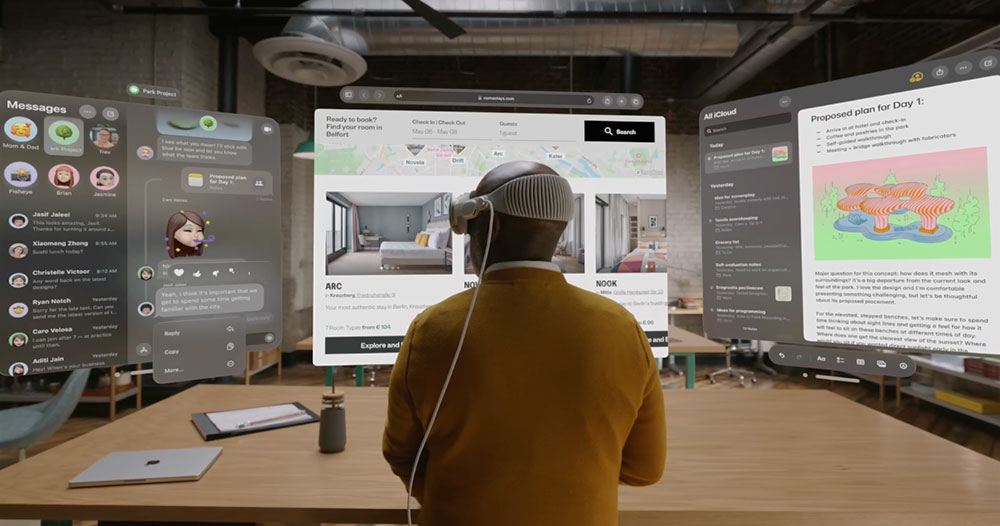Apple’s pricey Vision Pro augmented reality/virtual reality (AR/VR) headset hasn’t been a magnet for developers.
The Wall Street Journal reported Sunday that there has been a significant slowdown in apps being introduced in the Vision Pro app store. After hundreds of apps were introduced for the US$3,500 headset during its first two months on the market, it noted that new app intros have slowed to a trickle. In September, for example, only 10 new apps were debuted.
Citing numbers from analytics firm Appfigures, the Journal reported some 1,770 apps were available in the Vision Pro app store, although only 34% of those apps were built specifically for the Vision Pro. Most are versions of existing Apple apps with Vision Pro functionality.
The Journal pointed out that the growth of Vision Pro apps is far slower than that of other Apple products. Nearly a year after the iPhone’s introduction, it had 50,000 apps in the App Store, and Apple Watch had 10,000 apps within five months of launch.
However, the Journal acknowledged that the iPhone and Apple Watch had lower price points and wider consumer appeal than the Vision Pro.
It’s also more difficult to create apps for the AR/VR headset. “Developing for the Vision Pro means moving away from 2D app design and into an immersive, 3D interactive environment. It’s a new frontier, and porting existing apps isn’t a plug-and-play process,” explained Timothy Bates, a professor at the University of Michigan-Flint College of Innovation & Technology.
“Developers need to rethink user interfaces, user experiences, and how people interact with software in spatial computing. It’s a challenge, but one that brings exciting possibilities if done right,” he told TechNewsWorld.
Horse and Cart Problem
Bates asserted that it has been challenging for Apple to draw in a large pool of developers. “This is common with new platforms, especially ones as advanced as the Vision Pro,” he explained.
“Developers are hesitant to invest heavily when there’s a small initial user base, and when developing for mixed reality requires them to rethink conventional app design,” he said. “The tech itself is cutting-edge, but that also means a steeper learning curve.”
“I think it’s having trouble attracting smaller developers who have limited budgets and need to have a market that’s ready for monetization, which I do not believe the Vision Pro provides,” added Anshel Sag, a senior analyst with Moor Insights & Strategy, a technology analyst and advisory firm based in Austin, Texas.
“What it does provide for larger developers is familiarization with Apple’s spatial computing platform and the ability to optimize its data and workflows for future generations to be more affordable, lightweight, and refined.”
Mark N. Vena, president and principal analyst at SmartTech Research in Las Vegas, maintained that developers are not throwing their weight behind Vision Pro because sales volumes have been small. “The development community for Apple products is attracted to the mammoth volumes that they can get access to,” he told TechNewsWorld. “That’s certainly not true with Vision Pro.”
“With new hardware, there is always a horse and cart problem,” added Rob Enderle, president and principal analyst at the Enderle Group, an advisory services firm in Bend, Ore.
“Developers don’t want to create programs unless there is a critical mass of users, and users don’t want to buy the hardware until there are apps they want to use,” he told TechNewsWorld. “To get over this, typically companies have to fund the first set of apps, but Apple is really cheap and doesn’t typically do this well enough, which has become a problem again in this instance.”
Will Apple Fund Vision Pro Developers?
Vena predicted that Apple might start funding developers to make sure applications with a winning value proposition, and that really shows off this stuff, come to market.
“I can see them teaming up with some of the more high-profile developers to make sure those applications come to market,” he said. “My guess is you’re going to see Apple do that behind the scenes in a way that they haven’t had to do with the iPhone and iPad.”
“There’s no doubt that Apple is playing the long game here,” added Jim Squires, an XR and games consultant based in St. Catherines, Ontario, Canada.
“We’ll see both consumers and creators engage more with Apple’s spatial computing efforts when the cost comes down with future iterations,” he told TechNewsWorld, “but if Apple wants to have a pipeline of must-use software ready for that day, they should be stacking the deck now — and that means loudly and publicly funding more developers to take the plunge. Creating something like a Vision Pro Creator Fund to spur interest among XR developers would be a step in the right direction.”
Bates agreed. “Apple should absolutely invest in developers. They’ve done it before with new platforms, and Vision Pro is no different,” he said.
“By providing development grants or partnering with established AR/VR developers, Apple could give the Vision Pro a much-needed boost,” he maintained. “If you want a thriving ecosystem, you have to ensure developers can take risks and innovate without worrying about the financial burden.”
Success Depends on Ecosystem
Enderle contended that funding developers is generally a requirement for a device in this class to be successful. “Microsoft massively invested in apps for Windows 95 and for the Xbox, and both were successful,” he said.
But Sag doesn’t believe Apple is ready to open its coffers to developers. “It should fund developers, but it won’t because it believes that it has the most premium platform and the most captive customers with the willingness to spend,” he said.
“I think Apple should’ve given some seed funding to smaller developers before it launched the headset, but at this point, it has decided to let market dynamics work their magic,” he added.
Another way to encourage developers to create apps for Vision Pro is to open up the system, contended Jitesh Ubrani, a research manager at IDC, a global market research company. “Apple should embrace more open standards like OpenXR and WebXR that make developing across platforms easier and enable developers access to the most headsets.”
“It could also make a more affordable headset since there is a limited number of users globally willing and able to spend $3,500 on any device, let alone one as niche as a mixed reality headset,” he added.
Bates noted that Vision Pro has immense potential, but its success depends on the ecosystem around it. “Apple needs to ensure that developers feel incentivized to create groundbreaking apps that truly showcase the device’s capabilities,” he said. “It’s also essential to manage expectations — this is a forward-thinking product that will take time to mature, both in terms of hardware and software support.”
“Apple’s taking a bold step into the future with Vision Pro,” he added, “but they’ll need to nurture the developer ecosystem and likely roll out more accessible versions to see widespread adoption.”
Read the full article here
















